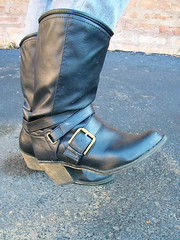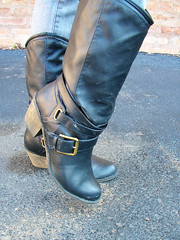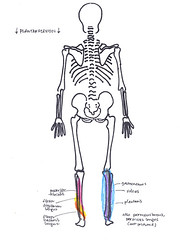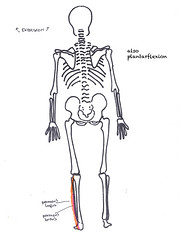What movements happen at this joint?
The foot is technically described as flexing towards its dorsal or top side, and also towards its plantar or bottom side. Dorsiflexion is what you probably commonly say as flexing your foot, and plantarflexion as pointing your foot.
If I've been told once, I've been told a thousand times to bend my knees. Better trainers like Coach Larry also tell you to bend your ankles, believe me, bend everything that bends. Everything that bends is a spring that you can load for power, power to hit, power to get the hell out of the pack. Etc.
What muscles make these movements happen?
That is supposed to be a cross section of gastrocnemus on top of soleus on top of plantaris. Also I have drawn gastrocnemus huge, having just bought knee high boots. Soleus, though, is actually larger than gastrocnemus.
The muscles that flex your foot at the ankle are your anterior tibialis, extensor hallucis longus, extensor digitorum longus, and peroneus tertius in your lower leg's anterior compartment. The extensors are called that because they also extend the toes, by the way.
The muscles that point your foot at the ankle are your posterior tibialis, flexor hallucis longus and flexor digitorum longus, which also by the way flex the toes, gastrocnemus, soleus, and plantaris in your lower leg's posterior compartment, which also contains the popliteus that we talked about at the knee. Peroneus brevis and peroneus longus in the lateral compartment are also involved in plantarflexion. A funny thing is how many muscles are involved in plantarflexion, which is what you need for running away from woolly mammoths.
What exercises make these muscles work?
Resisted inversion or eversion, which we will talk about in the next post, is recommended for most of these muscles. The book says cycling with toe clips for anterior tibialis, I presume that's because toe clips hold your feet in a flexed position. I don't know, I don't bike with toe clips.
Gastrocnemus, soleus, and plantaris are your calf muscles, my daikons! Anything jumping or generally going up exercises your calves: hill running, jumping rope, stair climbing, also obviously calf raises—for calf raises and stretches, you get at gastrocnemus more with a straight leg position and soleus with a bent knee position—and if you've seen The Triplets of Belleville, cycling.




